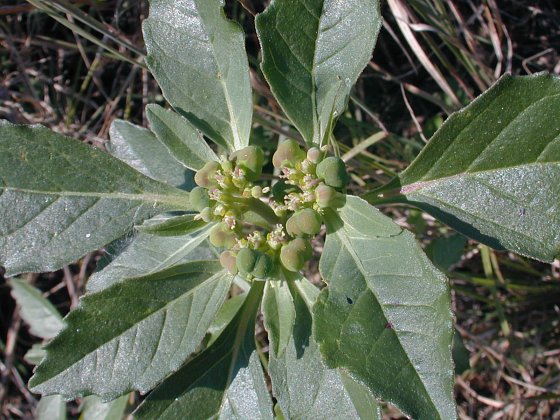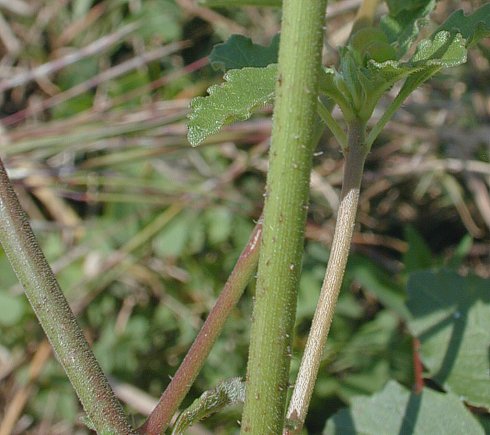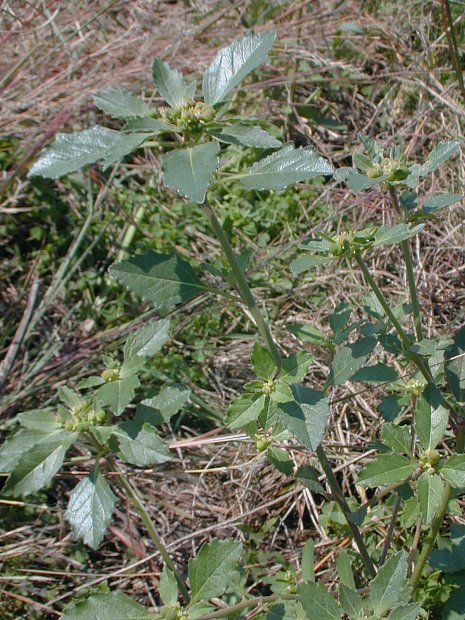Description: This plant is a summer annual that branches sparingly to occasionally; it is ¾–2' tall. The stems are light green or light reddish green, terete, finely short-pubescent, and sparsely to abundantly hairy. The leaves are opposite or alternate; they occur sparingly along the stems, except at their apices, where they occur in dense pseudo-whorls. The leaves are ¾–3" long and ¼-1" across; they are at least twice as long as they are across. Depending on the variety, the leaves are variably shaped; var. dentata has leaves that are elliptic-lanceolate to ovate, while var. cuphosperma has leaves that are linear-lanceolate to elliptic. The leaf margins are coarsely dentate. The leaf bases are wedge-shaped, while their tips are bluntly acute to acute. The upper leaf surfaces are medium to dark green and glabrous, while the lower leaf surfaces are light-medium to medium green and glabrous to short-pubescent along the lower sides of the veins. The petioles are 3-20 mm. (1/8–3/4") long, light green, glabrous to short-pubescent, and narrowly winged toward the leaf bases. The foliage of this plant exudes a white milky sap when it becomes damaged.

The stems terminate in flat-topped clusters of flowers spanning about ¾–2" across. Each cluster of flowers has several cyathia with a mixture of flowers and immature fruits; the cyathia and fruits are light green and glabrous, although sometimes the fruits become light red or purple in response to strong sunlight. A cyathium is a small cup-like structure spanning about 3 mm. (1/8") across that contains a single pistillate (female) flower and several surrounding staminate (male) flowers. These flowers are devoid of petals and sepals; their tiny reproductive organs are yellow, light pink, or white. Underneath the clusters of flowers, there are small leafy bracts up to ¾" long and ¼" across; they are few in number and linear-elliptic to elliptic in shape. The blooming period occurs from mid-summer to autumn, lasting about 1 month for a colony of plants. There is no noticeable floral scent. After blooming, the pistillate flowers are replaced with 3-lobed nodding fruits that span about 4-5 mm. across. These fruits are subgloboid (globoid and slightly flattened) in shape, and they are exserted from their cyathia on short curved stalks.

Each fruit
contains 3 seeds. Individual seeds are 2–2.5 mm. long
and slightly
less across, ovoid-globoid in shape, gray to nearly
black, minutely bumpy across the surface, and grooved along
one side. The root system consists of a taproot.
Cultivation:
The preference is full sun, mesic to dry conditions, and poor soil
containing significant amounts of clay, sand, or gravel.
Disease rarely bothers the leaves and drought resistance is excellent.
The seeds germinate after the weather becomes warm.
Range & Habitat:
The native Toothed Spurge occurs in almost all counties of Illinois
(see Distribution
Map), where it is occasional to locally common. Habitats
include disturbed areas of upland prairies (including gravel and sand
prairies), hill prairies, open upland thickets, limestone glades,
abandoned fields,
areas along cultivated fields, areas along railroads, areas
along
parking lots, roadsides, and open waste ground. Among these various
habitats,
Toothed Spurge is perhaps most common along railroads. This plant
favors open disturbed areas.

Faunal
Associations:
The flowers are probably visited by small bees, Syrphid flies,
and wasps; both nectar and pollen are available as floral rewards. A
flea beetle, Glyptina
cyanipennis, feeds on Toothed Spurge (Clark et al., 2004).
Some aphids feed on spurges (Euphorbia
spp.) and probably Toothed Spurge as well; these species
include Macrosiphum
euphorbiae
and Macrosiphum gei
(Hottes & Frison, 1931; Cranshaw, 2004). The seeds of
spurges are consumed by the Mourning Dove, Greater Prairie
Chicken, Bobwhite Quail, and Horned Lark (Martin et al.,
1951/1961). Because the milky latex in the foliage can irritate the
mouth parts and gastrointestinal tract of mammalian herbivores, it is
rarely consumed by them.
Photographic Location:
The photographs were taken at the Windsor Road Prairie in Champaign,
Illinois.
Comments:
Sometimes this plant is referred to as Euphorbia dentata.
Toothed Spurge is closely related to Wild Poinsettia (Poinsettia cyathophora);
this latter plant also occurs in Illinois. Wild Poinsettia
has upper leaves and bracts that turn red at their bases near the
inflorescence;
it is the showier of the two plants. Both of these plants are rather
weedy in their habits.